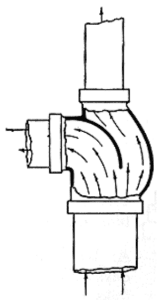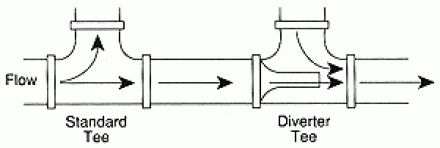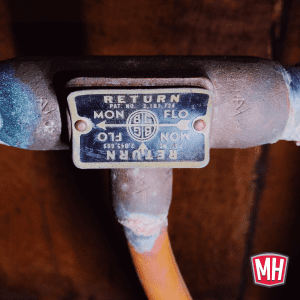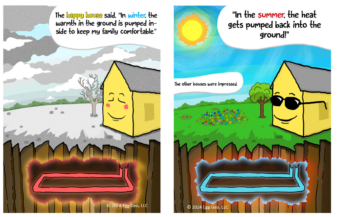Hydronics 201:
Last night I was called to a local farmstead for a no-heat in all of the bedrooms. Our typical Minnesota winter weather has finally returned so overnight temps are leveling out around -15F or lower so this was a priority call.
This particular system was originally installed 60+ years ago and has Bell & Gossett Monoflo tees; a very innovative [for the time] invention by B&G that made one-pipe hot water heating systems possible.
Why would we want to heat with one pipe?
At the time steam systems were the norm for heating both large buildings and homes so the folks selling hot water equipment were up against a wall. After all, you won’t be very competitive trying to sell a heating system that requires two pipes if your competition can do it with just one so the one pipe diverter system was born.
Why was this significant at the time?
 While Bell & Gossett branded their diverter tees the “Monoflo” they were not the first or only company offering such a product. Taco had the “venturi” tee but the roots of this whole idea can be traced back to Oliver Schlemmer, a Cincinnati, Ohio heating engineer who designed and patented his O-S fitting in the early days of this century. Here’s what the O-S fitting looked like:
While Bell & Gossett branded their diverter tees the “Monoflo” they were not the first or only company offering such a product. Taco had the “venturi” tee but the roots of this whole idea can be traced back to Oliver Schlemmer, a Cincinnati, Ohio heating engineer who designed and patented his O-S fitting in the early days of this century. Here’s what the O-S fitting looked like:
The O-S fitting is probably not even in use here in Minnesota but it was first installed for gravity hot water systems. The Monoflo or Venturi tee came later, after the invention of wet rotor circulators.
The diverter tee system made installing hot water heating systems in new homes less labor intensive; eliminated the need for large diameter pipes found in gravity systems and was competitive with the alternative but often dangerous steam systems.
How does it work?
With a standard tee fitting water can enter or exit in any variable of ways. We all understand this, that’s why there is no “inlet” or “outlet”, its just a tee, what goes into it has to come out of it. Goesinta/goesoutta as its said.
 A diverter tee changes everything about the tee by creating a roadblock to divert flow thru one “goesoutta” in preference over the other. This allows a single pipe to operate as botht eh supply and return for the heating loop, thus lowering the installed cost of labor and materials. Although I was not around way back then nor do I personally know anyone alive today that was, I can imagine resistance in the labor force and promotion of this “new technology” by plumbing shop owners. ProPress comes to mind…
A diverter tee changes everything about the tee by creating a roadblock to divert flow thru one “goesoutta” in preference over the other. This allows a single pipe to operate as botht eh supply and return for the heating loop, thus lowering the installed cost of labor and materials. Although I was not around way back then nor do I personally know anyone alive today that was, I can imagine resistance in the labor force and promotion of this “new technology” by plumbing shop owners. ProPress comes to mind…


The following is shared directly from and article titled “Monoflo Know-How From B&G”
Removal of radiators
If removal of a radiator or baseboard is needed in a diverter tee system for remodel or relocation purposes do not cap the two pipes that led to the radiator. If you cap the pipes that used to lead to the radiators, all the water will go through the run of the diverter tee. That increases the system pressure drop and slows the flow rate to the entire system.
If you remove a radiator, remove the tees as well. If that is impractical, just connect the two branches with a short length of copper tubing. That way, the water that used to go to the radiator will still have a place to go.
If air is a problem on start-up, raise the static pressure until you’ve cleared it.
More air will dissolve in water that’s under pressure. If you’re having a hard time getting rid of air on start-up, try raising the static fill pressure. The higher pressure drives free air into solution and brings it down to your air separator. Once you get the system going, lower the static pressure again. This is important because if you continue to operate at higher pressure, your compression tank may not be large enough for the system. Your relief valve will pop.
Pitch the main and the radiators up in the direction of flow.
This advice goes back to the original installation books of the 1930s. The pitch makes it easier to get rid of air on start-up. Check those pipes. They may have sagged as the years went by, and that can give an installer fits. If you’re having problems, always check the pitch.
Use the right amount of tees.
Radiators above the main usually work with one tee, and that tee should be on the return side. Radiators below the main always need two tees, and those tees should be the width of the radiator apart.
And keep in mind these rules apply to convectors and freestanding cast-iron radiators. The folks who invented the Monoflo fittings never imagined you’d be running 50 feet of copper baseboard from two tees piped six inches apart. The long run of baseboard puts too much pressure drop along the branch. The water responds by taking the path of least resistance along the run. The result? A cold radiator. And it looks just like an air problem!
If you have long runs of baseboard, run them as a separate zone.
Put your circulator on the supply, pumping away from the compression tank.
When you pump away from the compression tank, the circulator adds its pressure to the system’s static fill pressure. That drives air bubbles into solution and makes it much easier for you get rid of the air that appears when you start the burner. Usually, you’ll find you won’t have to bleed the radiators when you pump away.




Join the conversation: